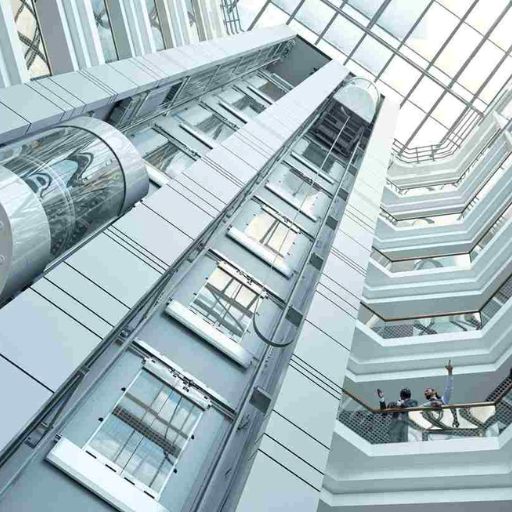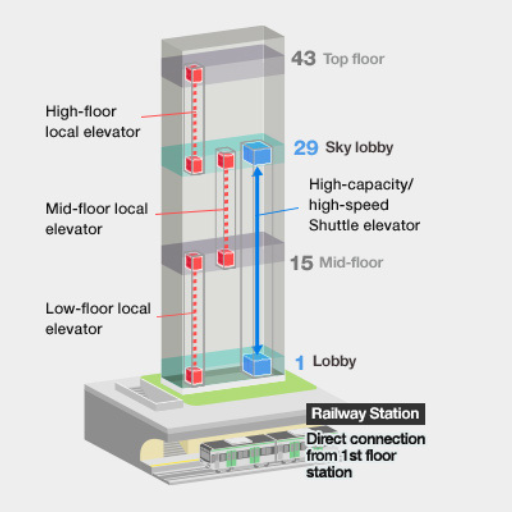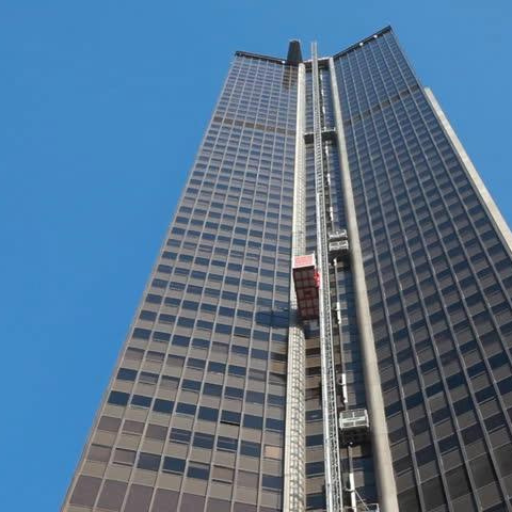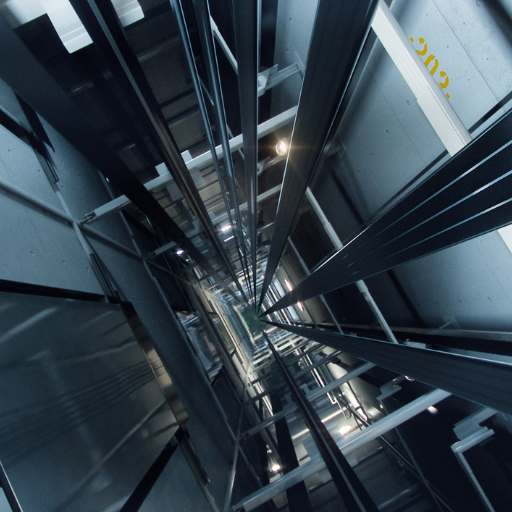As urban landscapes continue to evolve, the demand for efficient vertical transportation in skyscrapers has never been more critical. This blog aims to delve into the innovative elevator solutions that are revolutionizing the way we traverse these towering structures. From advanced technologies that reduce wait times to energy-efficient designs that minimize environmental impact, we’ll explore the latest trends and breakthroughs in the elevator industry. Whether you’re a building manager, architect, or simply fascinated by urban development, this article will provide valuable insights into the mechanisms that keep our cities moving upwards. Join us as we journey through the cutting-edge developments and future prospects of high-rise elevator systems.
What Types of Elevators Are Available for High-Rise Buildings?
Different Traction Types for a High-Rise Elevator
A few popular elevator systems exist in high-rise buildings:
- Traction Elevators: These are the most prevalent types of elevators found in tall buildings. They move using strong steel cables or belts. There are two types of traction elevators: geared and gearless. Geared ones are slow and suitable for mid-rises, while gearless traction elevators move faster and thus best for high rises since it covers longer distances with ease.
- Hydraulic Elevators: Hydraulic elevators, on the other hand, do not use overhead hoisting machinery like their traction counterparts but rather a hydraulic piston at the bottom of the shaft that pushes the elevator up. They are mainly used in low to mid-rise buildings because they have restrictions on travel distance and speed. Although normally not designed for high rise applications, some use have been made possible by engineering progressions in mid-rise scenarios where space and cost considerations are critical factors.
- Machine Room-Less (MRL) Elevators: An MRL elevator is similar to a traction elevator system; however, it does not need a dedicated machine room, meaning that this design can be quite attractive to developers who want to maximize spaces within high-rise structures. Moreover, these lifts can be used effectively both in low skyscrapers and sky-high edifices due to their compactness as well as operational effectiveness.
To sum up, selecting an appropriate type of elevator system in a tall building depends on such factors as velocity, efficiency, area limitations as well as energy consumption issues among others. These different kinds have unique advantages suitable for diverse building requirements based on recent developments in technology.
Schindler Elevators: The Pace-Setters In Extreme High-Rise Solutions
The vertical transportation sector has seen numerous innovations from Schindler Elevators with regard to high buildings. Their cutting-edge lift systems cater for skyscrapers’ demanding needs such as high velocity, energy efficiency, and utilization of the maximum space.
- Sustainability: The company emphasizes sustainability through application of regenerative drive technology aimed at saving energy while unused power is returned to the building grid. Consequently, this leads to a considerable reduction in energy consumption thus.
- Advanced Technology: With their Personal Occupant Requirement Terminal (PORT), Schindler has introduced a smart destination control system that optimizes horizontal movement for passengers thereby reducing waiting time and enhancing travel efficiency within the edifice.
- Safety and Comfort: State-of-the-art safety mechanisms as well as advanced control systems have been integrated into their operations in order to ensure a safe and smooth trip. These lifts are also famous for being quiet with comfortable cabins that create a good user experience.
Schindler Elevators has maintained its leadership position in the market by implementing innovative technologies and sustainable practices which deliver efficient, secure and environmentally friendly solutions for tall buildings.
Numerous Benefits of Modern High-Rise Elevators
Modern high-rise elevators bring an array of benefits, crucial for the efficient operation of tall buildings:
- High Speed: The transportation of passengers by the modern types of high-rise lifts is, as a matter of fact, done with speeds that range between 500 and 2,000 feet per minute. It is especially useful for skyscrapers since this greatly reduces time spent in travelling between floors.
- Energy Efficiency: Modern elevator models may send back as much as 30% of unused energy to the building’s power grid through technologies such as regenerative drive systems. This in turn lowers overall energy consumption and promotes sustainable building operation.
- Space Utilization: Designs of modern high-rise elevators are made to maximize space availability. In other words, they employ sophisticated systems that can work using small machine rooms or have no machine room at all hence releasing extra buildings spaces for various purposes.
- Passenger Handling: Elevators equipped with intelligent control systems like Schindler’s PORT Technology enable management of passenger flow by reducing waiting times and ensuring best travel routes. This can make a difference resulting in potential improvement in handling capacity up to 20-30% compared to traditional systems.
- Safety Features: Multiple safety features are incorporated into today’s elevators including such things as advanced braking systems, emergency power operations and real-time monitoring to guarantee security of passengers. By complying with standards such as EN 81-20/50 or ASME A17.1/CSA B44 codes, it secures high safety performance too.
- Noise Reduction: Improved cabins’ design and motor systems mean less noise while operating lifts leading to more comfortable rides by making them quieter than ever before. With soundproofing techniques being employed during operation, noise levels can be brought down to under 50 dBs.
These technical parameters emphasize the importance of modern high rise lifts in improving the efficiency, safety and sustainability of building operations.
Why Are High-Rise Elevators Essential for Skyscrapers?
Understanding the Functions of High-Rise Elevators in Tall Buildings
As for tall high-rise buildings, there can hardly be any doubts that their efficient operation would not be possible without high-rise elevators which handle a number of urgent issues.
- Efficient Vertical Transportation: In a high-rise structure, elevators are essential to rapidly and effectively transfer people from one floor to another thereby saving time and reducing physical load when compared with stairs.
- Space Utilization: By making room for new technologies like smaller or even no machine rooms, a lot of space will be available in tall buildings due to modern lifts and this space can be used otherwise.
- Technical Parameter: It is possible to have the system designed without machine rooms.
- Passenger Handling: Intelligent control systems enhance elevator efficiency and passenger handling capacity.
- Technical Parameter: For example, Schindler’s PORT Technology can boost handling capacity by 20-30%.
- Safety: State-of-the-art high-rise elevators come equipped with multiple safety devices like advanced braking systems, emergency power operations or real-time monitoring ensuring safe environment for people inside.
- Technical Parameter: They should conform to safety guidelines such as EN 81-20/50 or ASME A17.1/CSA B44.
- Noise Reduction: Improved motor systems and enhanced cabin designs have greatly reduced operational noise level thus making it more convenient for passengers while travelling.
- Technical Parameter: Noise levels could go down up to less than 50 dB during operation.
These factors indicate why skyscrapers cannot do without high-rise elevators as they combine technological innovation with practical benefits required for modern urban living arrangements.
Elevator Traffic Management in Busy Skyscrapers
Efficient elevator traffic management in busy skyscrapers is crucial to avoid congestion upon passengers’ arrival and reduce waiting time. Modern systems use intelligent algorithms and destination dispatch technology to optimize elevator operation. These systems also group together those traveling either on same floors or on nearby floors which helps increase vertical transportation efficiency and minimize travel time. Furthermore, predictive maintenance is enabled by IoT and data analytics to ensure that elevators run continuously thereby reducing the chances of delays. In addition to that, features such as real-time monitoring and adaptive control systems are activated when traffic patterns vary throughout the day so as to ensure a continuous flow of people even during peak times.
Capacity and Speed: Key Features of High-Rise Elevators
The capacity and speed of elevators in high-rise buildings are determining factors which make them effective or efficient. Modern high-rise elevators take many passengers at a go sometimes ranging from 20-50 depending on car dimensions or building specifications. Besides, the pace is also admirable with the latest models achieving a maximum velocity of 45 mph (20 meters per second). This fast vertical movement helps to reduce waiting times while traveling particularly during peak hours. Additionally, double-decker lifts and smart destination control systems are examples of advanced technologies used to increase capacity and speed thus providing an easy way for moving up skyscrapers efficiently.
How Do Elevators Contribute to High-Rise Building Efficiency?
Revitalizing the flow of traffic through passenger lobbies
There are several strategies and technical parameters that can both increase efficiency and reduce waiting times when it comes to improving the flow of people in high-rise buildings with passenger elevators.
The main ones are:
- Destination Control Systems (DCS): These systems minimize stops, shorten travel time and group passengers travelling to the same or adjacent floors. DCS anticipates traffic patterns thus optimizing elevator dispatching.
- Technical Parameter: Grouping of passengers helps cut down average travel time by 30%.
- Double-Decker Elevators: In these elevators, two cabins stacked on top of each other double the number of passengers that can be transported at once without requiring any additional shaft space.
- Technical Parameter: Increases passenger capacity by 50% per shaft.
- High-Speed Elevators: Modern high-rise elevators can attain speeds up to 20 m/s (45 mi/h), thus cutting down considerably on transit times between floors.
- Technical Parameter: A speed of twenty meters per second is roughly equivalent to seventy-two kilometers an hour.
- Predictive Maintenance: Among other things, predictive maintenance employs IoT sensors and data analytics to ensure smooth operation of lifts with minimal downtime.
- Technical Parameter: Reduces elevator downtime by up to 40%.
- Adaptive Control Systems: The use of real-time data for adjusting elevator operations depending on existing traffic conditions ensures optimal performance during peak load hours as well as off-peak periods.
- Technical Parameter: For example, during peak hours efficiency may go up by 25%.
In conclusion, incorporating these state-of-the-art technologies and strategies will dramatically improve the traffic flow situation for passenger elevators in tall buildings.
Energy Efficiency in Modern High-Rise Elevator Systems
Modern high-rise lift systems are designed with a great deal of emphasis being put on energy efficiency through many technological advancements. One important thing that regenerative drives do is capture braking energy which they convert into electrical power that can be disseminated to the grid of the building. Another modernization is use of light weight materials and advanced lubrication techniques which reduce energy consumption that is involved in moving elevator cars. Lastly, smart controls as well as optimized algorithms enable elevators to operate at their most efficient level thus reducing idle times and optimizing travel schedules. All these energy saving approaches reduce environmental impact and operational costs associated with high-rise buildings hence promoting sustainability and economic efficiency within urban landscapes.
What Safety Features Are Included in Modern High-Rise Elevators?
Safety in High-Rise Elevator Designs
High-rise elevator designs put safety first and incorporate a range of sophisticated features to ensure the well-being of passengers. With emergency brakes, speed governors, and strong door sensors to prevent accidents if doors are obstructed, modern elevators have multiple layers of safety mechanisms. In case of unexpected circumstances such as a power outage, automatic emergency communication systems are also wired up for immediate help. These are complemented by strict maintenance schedules and adherence to tough safety standards and regulations.These efforts guarantee that high-rise building lifts provide efficient transportation as well as security for everyone.
Elevators’ Technologies Ensuring Passengers’ Safety
Modern high rise elevators employ several advanced technologies in order to keep passengers safe. Among others, these features include;
- Emergency Brakes: they automatically come on when the car moves at higher speeds than what is considered safe driving capability. Normally electromagnetic brakes work during breakdown or sudden stops.
- Speed Governors: monitor the speed of the elevator car; it has an emergency brake that comes on when the car surpasses its allowed velocity limits thereby enhancing control over operations.
- Robust Door Sensors: Advanced sensor technology ensures that whenever elevator doors come into contact with obstacles, they reopen reducing potential injury risks. For accurate detection purposes usually infrared or pressure sensitive technology is used in such sensors.
- Automated Emergency Communication Systems: Intercoms or emergency phones which directly connect with building’s security personnel or emergency services act as backup communication units where there are emergencies like mechanical failures or power blackouts thus immediate help can be sought.
- Backup Power Systems: High-rise elevators have backup power supply like batteries or generators so that even if electricity goes off, the lift can reach next floor and open its doors.
- Seismic Sensors: For earthquake prone areas, elevators are fitted with seismic sensors. Once these detect any form of tremors, they automatically stop the car on nearest floor hence facilitating safe exit by occupants.
- Firefighters’ Operation Mode: Modern elevators have a special mode that is activated during a fire emergency, allowing firefighters to use the elevator safely to reach affected floors, improving rescue and evacuation processes.
By adhering strictly to international safety standards such as ASME A17.1 and EN 81 through regular maintenance inspection schedules, these technologies collectively guarantee safe, reliable transport in high-rise elevator systems.
How Does Elevator Technology Impact Skyscraper Design?
Elevator Shafts Integration in Building Architecture
When it comes to designing skyscrapers, one aspect that cannot be ignored is the integration of elevator shafts. This process involves arranging these shafts wisely to ensure efficiency of space and easy movement from one floor to another. Elevators must be located strategically with easy accessibility as they do not affect the major structural elements of a building’s core. This often involves the practice of gathering elevator shafts together within central cores instead. Not only does this enhance more efficient vertical travelling but also strengthens the structure of tall buildings. Additionally, factors like number of elevators, type (such as express or local), and inclusion of elevator lobbies at proper intervals are all crucial in creating a functional and effective vertical transportation system within the architectural design of a skyscraper.
What Are Some Challenges Faced when Designing Skyscrapers?
Designing lifts for high rise buildings is fraught with numerous technical and logistic problems which require careful study and precise engineering. The main problem lies in managing vertical travel distances since skycrapers can attain great heights. At such distances, there should be high performance motors and advanced control systems that make sure elevators operate efficiently without compromising safety.
Key Technical Parameters:
- Speed: To reduce passenger travel time, elevators in high-rise buildings usually have speeds between 5 – 7 meter/second (1,000-1,400 feet per minute).
- Capacity: High capacity elevators rated up to 3,300 kg – 5,500 lbs are essential because a large number of passengers usually use such systems.
- Power Supply: These highly energy demanding systems need effective power management with modern lifts using regenerative drives that feed excess energy into the building’s power system.
- Control Systems: Advanced destination control systems group passengers heading for similar floors thus reducing wait times for elevators during peak hours.
- Safety Mechanisms: Comprehensive safety measures such as redundant braking systems; seismic sensors; and fire rated, elevator shafts are necessary to ensure that the passengers remain safe.
Building sway due to wind or seismic activity is another formidable challenge, which can be addressed by incorporating damping systems within the elevator mechanism so that it absorbs and cancels out such movement ensuring smooth and stable operation.
Additionally, designing for high traffic volumes during peak times necessitates an efficient elevator dispatch strategy, often involving a combination of express and local elevators. This logistical consideration minimizes delays in boarding and congestion.
Overall, these technical parameters alongside design factors are critical when it comes to mitigating challenges of vertical transportation in skyscrapers thereby providing dependable, effective as well as safe lifts system specifically suited for high rise architecture.
Future Trends in Elevator and Escalator Technologies for Skyscrapers
Dealing with Space Constraints in Elevator Design
Maximizing utility in skyscrapers requires addressing the issues of space limitations in elevator design. One such solution is the Multi system which uses magnetic levitation, and it is ropeless allowing multiple elevator carriages to operate on one shaft moving vertically as well as horizontally. This not only optimizes on space but also reduces waiting time and improves movement efficiency. Alternatively, double-deck elevators can be employed that serve two floors at once thereby doubling the carrying capacity within the same shaft dimensions. Lastly, employing slim profile high strength cables and compact motor technology permits narrower shafts hence saving valuable floor area while upholding safety and performance standards. These improvements collectively represent a dedication to making vertical transport more efficient and adaptable to space constraints of contemporary tall buildings.
Managing Elevator Traffic in Tall Buildings
It’s an intricate task to control traffic through lifts in high-rise buildings requiring different strategies for ensuring efficiency and lowering delays. For instance, destination control systems can be used where passengers select their desired floor before entering into an elevator. By doing so, such systems optimize the route of travel by grouping together people traveling either to the same or nearby floors therefore making fewer stops thus bettering overall traffic flow between them Another way involves using advanced AI algorithms that predict usage patterns and adjust elevator operations dynamically based on real-time data being received from sensors mounted inside it. Consequently, this method helps shift loading across all available lifts more uniformly without getting any problems with an overload weight indicator going off shortly after leaving ground level premises Also, smart scheduling systems may come handy during peak hours by prioritizing increased number of trips thereby ensuring smooth operation of vertical transportation for every occupants especially when they are needed most . These futuristic techniques develop maintenance of lift traffic thus leading to efficaciousness within sky scrapers.
Ensuring Reliability and Performance in High-Rise Elevators
In order to ensure reliability and performance of my high-rise elevators, I focus on several areas. First of all, I implement regular maintenance schedules that involve thorough inspections and timely repairs in order to avoid unexpected breakdowns. Real-time tracking of elevator performance through advanced monitoring systems allows me to prevent problems before they occur. Moreover, high-quality components and materials should be used as this is a key requirement for the durability and smooth operation of elevators. Furthermore, elevators can be kept at peak efficiency by continually upgrading their system such as software updates and modernization of mechanical parts. Finally, I have robust safety protocols and emergency response plans in place to ensure passenger well-being at all times. These strategies collectively preserve the reliability and performance standards necessary for high-rise elevators.
Frequently Asked Questions (FAQs)
Q: What are the primary differences between low-rise and mid-rise elevators?
A: Low-rise lifts are usually found in buildings up to five or six stories, but mid-rise lifts are used for buildings from six to twenty floors. For each type of such lifts different solutions for movement corresponding to height and use intensity of a building.
Q: How can mobility solutions improve the efficiency of elevator and escalator rides in high-rise buildings?
A: Mobility solutions like the Schindler 7000 traction elevator can help improve efficiency by allowing passengers to place elevator calls in advance, thereby reducing waiting times and optimizing traffic flow inside a building.
Q: What are some benefits of choosing a low-rise elevator for a small building?
A: Low–rise vertical transportation alternatives can provide cost-effective measures to proprietors. TK Elevator’s low rise models find immense application within smaller structures characterized by dependable operations as opposed to higher costs associated with taller heights.
Q: How does Schindler Climb technology benefit high-rise construction projects?
A: Schindler Climb is an innovation that permits elevators to expand as the structure grows. It boosts constructability by letting contractors use hoistways to haul things encouraging shorter project durations.
Q: What are some versatile elevator upgrades that can be customized to enhance existing installations?
A: Offerings by Schindler include ways of restoring your lift or replacing your entire system including modernization packages customized according to building requirements. These upgrades include among other things state-of-the-art controls, energy saving motors, ergonomic designs that increase passenger comfort.
Q: Why is it important to discover Schindler’s history when considering their mobility solutions?
A: Uncovering the rich background behind this company provides insights into decades of innovativeness and long service delivery in mobility solutions. They have good experience which gives them confidence in quality work therefore they have become famous worldwide as works mainly deals with iconic buildings.












